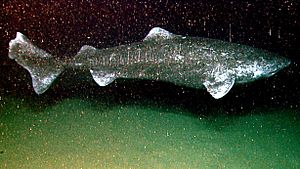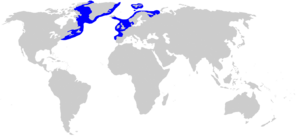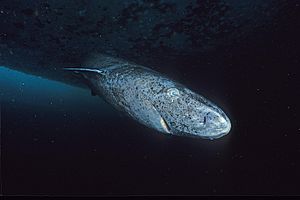Greenland shark facts for kids
Quick facts for kids Greenland shark |
|
|---|---|
 |
|
| Conservation status | |
| Scientific classification | |
| Genus: |
Somniosus
|
| Species: |
microcephalus
|
 |
|
| Range of the Greenland shark | |
| Synonyms | |
|
|
The Greenland shark (Somniosus microcephalus) is also known as the gurry shark or grey shark. In the Kalaallisut language, it is called eqalussuaq. This huge shark belongs to the "sleeper shark" family, Somniosidae. It is closely related to the Pacific and southern sleeper sharks.
The Greenland shark lives in the cold waters of the North Atlantic and Arctic Oceans. It is a very important but not well-studied species. It holds the record for the longest known lifespan of any animal with a backbone. Scientists believe it can live between 250 and 500 years! It is also one of the largest sharks alive today.
This shark eats many different kinds of food. Its body contains a lot of a chemical called trimethylamine N-oxide. This chemical makes its meat poisonous if eaten raw. However, in Iceland, the meat is specially treated to remove the toxins. It then becomes a famous dish called kæstur hákarl. Because it lives in deep, cold waters far from people, the Greenland shark is not known to attack humans. No attacks have ever been recorded.
Contents
About the Greenland Shark
The Greenland shark is one of the biggest living shark species. It usually grows to be about 2.4 to 7 meters (8 to 23 feet) long. It can weigh between 400 and 1,400 kilograms (880 to 3,090 pounds).
Male sharks are usually smaller than females. This shark is a thick, strong species. It has a short, rounded snout and small eyes. Its dorsal (top) and pectoral (side) fins are very small for its size. The gill openings are also quite small.
The shark's color can be light creamy-gray to blackish-brown. Its body usually has one solid color. Sometimes, you might see whitish spots or faint dark stripes on its back.
Its Teeth
When a Greenland shark eats large prey, it uses a special jaw movement. It rolls its jaw to cut off big pieces of food. The shark has 48 to 52 teeth in its upper jaw. These teeth are very thin, pointed, and smooth. They act like anchors, holding the prey still.
The lower jaw also has 48 to 52 teeth. These teeth fit together like puzzle pieces. They are broad and square-shaped. They have short, smooth points that stick outwards. The teeth on each side of the lower jaw point in opposite directions. This helps the shark cut through tough food.
How Greenland Sharks Live
What They Eat
The Greenland shark is an apex predator, meaning it's at the top of its food chain. It mainly eats fish. However, scientists have seen them actively hunting seals in Canada. The food found in their stomachs shows they are active hunters.
They have been found with smaller sharks, skates, eels, and many other fish like herring and cod. Smaller Greenland sharks mostly eat squid. Larger sharks (over 200 cm or 6.5 feet) eat fish that live near the seabed, as well as seals. The biggest sharks have even eaten redfish.
Greenland sharks are slow swimmers. Because of this, they often hunt prey that are asleep. They use their natural camouflage (colors that help them blend in) to get close. Then, they open their large mouths quickly. This creates a suction that pulls the prey inside. This is likely why they often swallow their prey whole.
These sharks have also been found with parts of seals, moose, and even entire reindeer bodies in their stomachs. The Greenland shark is also a scavenger. This means it eats dead animals. It is attracted to the smell of rotting meat in the water. Sharks are often seen gathering around fishing boats. They also scavenge on dead seals.
Even though a shark this big could easily eat a human, the freezing waters it lives in make attacks very unlikely. No verified cases of Greenland sharks attacking humans have ever happened.
How They Move
The Greenland shark is a cold-blooded animal. It lives in water that is just above freezing. It has the slowest swimming speed and tail-beat frequency of any fish its size. This is probably because it has a very slow metabolism and lives for a very long time. It swims at about 1.2 kilometers per hour (0.76 mph). Its fastest speed is only about 2.6 kilometers per hour (1.6 mph).
Since this top speed is much slower than a typical seal, scientists wonder how the sharks catch seals. They think the sharks might ambush seals while they are sleeping.
Greenland sharks move each year based on water depth and temperature. They don't travel long distances. In winter, they gather in shallower waters (up to 80° north) to stay warm. In summer, they move to deeper waters or farther south. This species has been seen as deep as 2,200 meters (7,200 feet). This was near the wreck of the SS Central America off North Carolina. They also move up and down between shallower and deeper waters each day.
In 2013, researchers found a Greenland shark in the Gulf of Mexico. It was at a depth of 1,749 meters (5,738 feet), where the water was 4.1°C (39.4°F). This was a rare sighting. Other records of Greenland sharks have come from Cuba and the northern Gulf of Mexico. Usually, they live at depths of 0 to 1,500 meters (0 to 4,900 feet). They are often in shallow waters in the far north. They go deeper in the southern parts of their range.
In 2022, a large Somniosus shark was caught and released off the coast of Belize. This shark was thought to be either a Greenland shark or a mix of Greenland and Pacific sleeper shark. This was the first possible sighting of a Greenland shark in the Western Caribbean. It was also caught near a coral reef. This suggests that Greenland sharks might live in more tropical areas than we thought, especially in deeper waters.
Other Behaviors
The Greenland shark often has a small crustacean called Ommatokoita elongata attached to its eyes. This tiny animal is a copepod. Some people thought the copepod might glow in the dark. This could attract prey for the shark, helping both of them. However, this idea has not been proven. These parasites also harm the shark's eyes, making it almost completely blind. But this doesn't seem to affect the shark's life or its ability to hunt. This is because Greenland sharks rely heavily on their sense of smell and hearing. The shark prefers very cold water, usually between -0.6°C and 12°C (30.9°F and 53.6°F).
When brought onto a ship, it thrashes its tail so much that it's dangerous to be near it. Sailors usually kill it quickly. Even after it dies, the cut pieces of its muscle keep twitching for some time. It is very hard to kill. It's not safe to put your hand in its mouth, even if its head has been cut off. And, if we believe Crantz, this movement can still be seen three days later if the part is stepped on or hit.
Longevity
The Greenland shark has the longest known lifespan of any animal with a backbone. One shark was tagged in 1936 and caught again in 1952. Its size suggested that Greenland sharks grow very slowly, about 0.5 to 1 cm (0.2 to 0.4 inches) per year.
In 2016, a study looked at 28 sharks. They ranged from 81 to 502 cm (2.6 to 16.5 feet) long. Scientists used radiocarbon dating on crystals in their eye lenses to guess their ages. The oldest and largest shark in the study had lived for about 392 years, give or take 120 years. This means it was born sometime between 1504 and 1744. The study also found that these sharks become adults and can have babies when they are about 150 years old. Because they live so long and take so long to mature, it is very important to protect Greenland sharks.
Reproduction and Life Cycle
Scientists discovered in 1957 that female Greenland sharks do not lay eggs in the mud. Instead, they keep the developing babies inside their bodies. The babies are born alive. This process is called ovoviviparity. It is thought that the pregnancy lasts between 8 and 18 years.
A normal litter has about ten pups. Each pup is about 38 to 42 cm (15 to 16.5 inches) long when born. Inside the mother shark, special structures help give oxygen to the growing babies. Because they live so long, Greenland sharks are estimated to have between 200 and 700 pups in their lifetime.
Special Body Features
Like other elasmobranchii (sharks and rays), Greenland sharks have high amounts of two chemicals in their bodies: urea and trimethylamine N-oxide (TMAO). These chemicals help them float better. They also protect their cells from the high pressure of deep water. TMAO also helps keep their body proteins stable. The amount of TMAO in fish tissues increases the deeper they live.
The blood of Greenland sharks has special types of hemoglobin. Hemoglobin carries oxygen in the blood. These hemoglobins don't hold onto oxygen as tightly as those in sharks from warmer waters. These features are special adaptations that help them live in very deep, cold waters.
Greenland Shark as Food
The meat of the Greenland shark is poisonous. This is because it has a lot of trimethylamine oxide (TMAO). If you eat the meat without treating it, the TMAO turns into another chemical that can make you sick. Sometimes, sled dogs that eat the raw meat can't stand up because of this effect. The related Pacific sleeper shark also has this toxic meat, but most other shark species do not.
To make the meat safe to eat, it must be treated. This can be done by boiling it many times, drying it, or fermenting it for several months. The fermented meat is called kæstur hákarl. Traditionally, the meat is buried in the ground for 6 to 8 weeks. This squeezes the TMAO out and also starts the fermentation process. After that, the meat is dug up and hung in strips to dry for several more months. It is considered a special food in Iceland.
Inuit Legends
The poisonous meat of the Greenland shark, with its high urea content, led to an Inuit legend. The legend tells of Skalugsuak, the first Greenland shark. It says that an old woman washed her hair in urine (which was a common way to kill head lice). She dried her hair with a cloth. The cloth blew into the ocean and became Skalugsuak. Another legend says that Sedna's father cut off her fingers as he drowned her. Each finger turned into a sea creature, including Skalugsuak.
The Greenland shark is important in the beliefs of the Inuit people from the Canadian Eastern Arctic and Greenland. The Igloolik Inuit believe that the shark lives in the urine pot of Sedna, the goddess of the sea. Because of this, its meat smells like urine. They also believe it acts as a helpful spirit for shamans (spiritual leaders).
Importance and Protection
Role in Arctic Ecosystems
Greenland sharks are both scavengers and active hunters. This means they are top predators in the Arctic. They eat many different fish, seals, and other animals. They play a very important role in the complex food web of the Arctic.
Conservation and Management
Greenland sharks are known as the longest-living animals with backbones on Earth. They grow slowly, become adults late in life, and don't have many babies. This makes it very important to manage and protect this species. Because they reproduce slowly and live so long, they are very sensitive to overfishing. If too many are caught, their numbers can drop quickly. So, their long lives and slow life cycle, along with the risk of being caught by accident or in commercial fishing, raise concerns about their future.
Threats to the Greenland Shark

In the past, Greenland sharks were hunted for their liver oil. This continued until the 1960s when artificial oils were developed. In the 1970s, the shark was seen as a problem for other fisheries in western Norway. The government even paid people to fish for them to reduce their numbers.
Today, about 3,500 Greenland sharks are caught each year by accident. This happens in the Atlantic and Arctic Oceans and the Barents Sea. More than 1,000 sharks are caught every year from Arctic waters down to USA waters. In the Barents Sea alone, about 1,200 Greenland sharks are caught each year.
The amount, movement, and spread of Arctic sea ice likely affect the sharks. The ongoing loss of sea ice will continue to harm the sharks. It will reduce their food sources and change where they live. At the same time, less ice means fishing boats can reach more areas. This could lead to new fisheries developing as more fish from warmer waters move into the warming Arctic.
See also
 In Spanish: Tiburón boreal para niños
In Spanish: Tiburón boreal para niños





